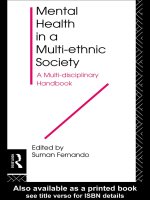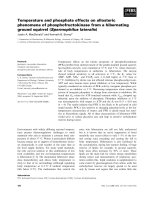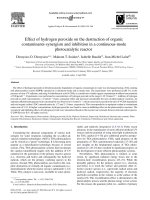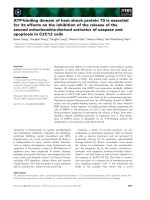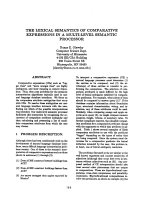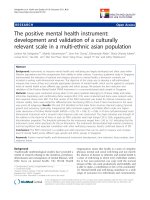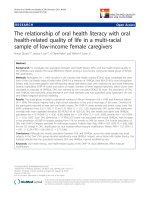Traditional birthing practices in a multi cultural society effects on womens sense of well being, support and breastfeeding self efficacy
Bạn đang xem bản rút gọn của tài liệu. Xem và tải ngay bản đầy đủ của tài liệu tại đây (2.07 MB, 168 trang )
TRADITIONAL BIRTHING PRACTICES IN A
MULTI-CULTURAL SOCIETY: EFFECTS ON
WOMEN’S SENSE OF WELL-BEING, SUPPORT
AND BREASTFEEDING SELF-EFFICACY
ELIANA NASER
Master in Healthcare Management, (Sydney), B.HS,
Nursing (Sydney), Advanced Diploma in Critical Care
Nursing (Singapore)
A THESIS SUBMITTED FOR THE DEGREE OF
DOCTOR OF PHILOSOPHY (NURSING)
ALICE LEE CENTRE FOR NURSING STUDIES
NATIONAL UNIVERSITY OF SINGAPORE
2012
i
ii
Acknowledgements
I would like to acknowledge the supervision and support provided by
Professor Debra Creedy, Dr Piyanee Yobas, and Dr Sandra Mackey. They
willingly gave invaluable guidance and constructive criticism in relation to
this research.
To my parents, husband, and siblings, I thank them for their understanding,
patience, interest, and endless support and love.
Finally, I am indebted to all the women who so willingly gave of their time to
share their experiences of birth and without whom this study would not have
been possible.
Statement of Originality
This work has not been previously submitted for a degree or diploma in any
university. To the best of my knowledge and belief, this thesis contains no
material previously published or written by another person except where due
reference is made in the thesis itself.
Eliana Naser
iii
Table of Contents
Acknowledgements ii
Statement of Originality ii
Table of Contents iii
Summary viii
Background viii
Aims viii
Methods viii
Results of the study ix
Conclusion x
List of Tables xi
List of Figures xii
Glossary of terms xiii
List of Symbols xv
Chapter 1 Introduction 16
1.1 Research aims 18
1.2 Significance of the research 18
1.3 Organisation of the thesis 19
Chapter 2 Literature Review 21
2.1 Introduction 21
2.2 Traditional birthing practices 22
2.2.1 Concept of ‘hot’ and ‘cold’, and ‘humoral theory’ 22
2.2.2 Antenatal traditional birthing practices 23
2.2.3 Concept of ‘conception’ 24
2.2.4 Behavioural precautions in antenatal period 24
2.2.5 The ceremony of ‘rocking the abdomen’ 25
2.2.6 Dietary practices during pregnancy 26
2.2.7 Fasting in pregnancy 27
2.2.8 Factors influencing adherence and traditional antenatal practices
28
2.3 Labour/Birth traditional birthing practices 29
2.3.1 Treatment of the placenta 30
2.4 Postnatal traditional birthing practices 30
2.4.1 Confinement period 31
2.4.2 Behavioural practices during the postnatal period 32
2.4.3 Applying hot stones 33
iv
2.4.4 Staying indoors 33
2.4.5 Pampering the mother 34
2.4.6 Sexual activity 34
2.4.7 Bathing restrictions 35
2.4.8 Diet during the postnatal period 35
2.4.9 Toxic foods to avoid 36
2.4.10 Traditional medicines 37
2.5 Emotional well-being 37
2.6 Social Support 39
2.7 Breastfeeding self-efficacy 40
2.8 Implications of the review for the proposed study 42
2.9 Conclusion 43
Chapter 3 Phase 1: Methods and Findings 45
3.1 Introduction 45
3.2 Purpose of Phase 1: The qualitative study 45
3.3 Research questions 46
3.4 Research design 46
3.5 Recruitment 47
3.5.1 Sample 47
3.5.2 Inclusion/Exclusion criteria 47
3.5.3 Ethical considerations 47
3.5.4 Data collection 48
3.5.5 Approach to data analysis 49
3.6 Rigour 51
3.7 Participants 51
3.8 Findings 52
3.8.1 Theme 1: Following tradition 53
3.8.2 Filial piety 53
3.9 Worry about consequences 55
3.9.1 Worry about being sick in later life 55
3.10 Fear for the well-being of the baby 57
3.11 Worry about going against tradition 58
3.12 Theme 2: Challenging tradition 59
3.12.1 Seeking information in new ways 59
3.12.2 Modification and rejection of practices 60
3.13 Changing family 61
3.14 Gender preference 61
v
3.14.1 Structures for support and caregiver roles 62
3.15 Discussion 63
Chapter 4 Phase 2: Methods and Findings 66
4.1 Introduction 66
4.2 Design of the study 67
4.3 Setting 67
4.4 Sampling design 67
4.5 Sample size calculation 68
4.6 Inclusion criteria 68
4.7 Exclusion criteria 69
4.8 Instrument 69
4.9 Pilot testing of Traditional Birthing Practices Questionnaire 71
4.10 Edinburgh Postnatal Depression Scale (EPDS) 71
4.11 Duke-UNC Functional Social Support Questionnaire (FSSQ) 72
4.12 Breastfeeding Self-Efficacy Scale-Short Form (BSES-SF) 72
4.13 Demographic data 72
4.14 Recruitment process 72
4.15 Ethical considerations 73
4.16 Statistical procedures 74
4.17 Stage 1: preliminary analyses 74
4.18 Stage 2: reliability analyses 74
4.19 Stage 3: Specific analyses to address the research questions of the
study 75
4.20 Interpreting statistical outcome 76
4.21 Results 77
4.21.1 Characteristics of the sample 77
4.21.2 Age of participants 77
4.21.3 Ethnicity 77
4.21.4 Religion 78
4.21.5 Marital status 78
4.21.6 Years of marriage 78
4.21.7 Living arrangements 78
4.21.8 Number of children 79
4.21.9 Gender of infant 79
4.21.10 Education 79
4.21.11 Employment status and occupation 79
4.21.12 Type of housing 80
vi
4.21.13 Monthly household income 80
4.22 Sources of information on traditional birthing practices 82
4.23 Changes that women would like to make during the perinatal
period 82
4.24 Factor analysis of the Traditional Birthing Practices Questionnaire
(TBPQ) 82
4.25 Reliability of instruments 86
4.26 Traditional birthing practices adhered to by Singapore women 87
4.27 Traditional birthing practices: dietary practices 88
4.28 Traditional birthing practices: antenatal activities 89
4.29 Traditional Birthing Practices: labour and postnatal practices 89
4.30 Differences in traditional birthing practices among Chinese, Malay,
and Indian women 91
4.31 Activities during labour/delivery 93
4.32 Behavioural activities and diet during the postnatal period 94
4.33 EPDS score 95
4.34 DUKE-UNC (FSSQ) score 95
4.35 BSES-SF 96
4.36 Relationship between variables 96
4.37 Effects of traditional birthing practices on emotional well-being,
social support, and breastfeeding self-efficacy 97
4.38 Effects of traditional birthing practices on women’s sense of well-
being 97
4.39 Effect of traditional birthing practices on women’s perceived social
support 98
4.40 Effect of traditional birthing practices on breastfeeding self-
efficacy 98
4.41 Conclusion 99
Chapter 5 Discussion 101
5.1 Introduction 101
5.2 Traditional birthing practices of Singaporean Chinese, Malay, and
Indian women 102
5.3 Differences in traditional birthing practices among Singaporean
Chinese, Malay, and Indian women 108
5.4 Effects of traditional birthing practices on emotional well-being,
social support, and breastfeeding self-efficacy 111
5.5 Effect of traditional birthing practices on emotional well-being . 111
5.6 Effect of traditional birthing practices on women’s sense of social
support 113
vii
5.7 Effect of traditional birthing practices on breastfeeding self-
efficacy 114
5.8 Limitations and future research 115
5.9 Implications for nursing and healthcare professionals 117
5.10 Implications for nurse/midwifery education and continuing
professional development 120
5.11 Implications for education: women and their families 121
5.12 Summary 121
Chapter 6 Conclusions 122
Bibliography 127
Appendix – Related Documents 144
Letters of Approval 144
Questionnaire 148
viii
Summary
Background
This study explored traditional birthing practices of Singaporean women who
live in a contemporary multicultural society. It examined the impact of these
practices on women’s sense of well-being (as measured by depressive
symptoms), perceived social support, and breastfeeding self-efficacy. This
two-phase study consisted of a qualitative and quantitative data collection
phase.
Aims
The aims of this study were to identify the traditional birthing practices of
Singaporean Chinese, Malay and Indian women and their effect on emotional
well-being, social support and breast feeding self-efficacy.
Methods
Phase 1 of the study consisted of face-to-face interviews with a purposeful
sample of 30 women recruited from outpatient maternity clinics in a tertiary
hospital in Singapore. The analysis using Colaizzi’s method, identified
women’s perceptions of their traditional birthing practices, reasons for
adherence, and sources of influence. These findings were used to inform the
development of a questionnaire that was piloted and distributed to postnatal
women in Singapore.
Phase 2 of the study was conducted in three tertiary hospitals in Singapore,
from March 2010 until July 2010. Women attending their sixth week
postpartum clinic visit were recruited. Five hundred and twenty women
(n= 520) participated in the survey on traditional birthing practices, sources of
influence, reasons for adherence, symptoms of postnatal depression,
perceptions of social support, and breastfeeding self-efficacy. Questions
included: (1) antenatal traditional birthing practices; (2) antenatal dietary
ix
practices; (3) labour and delivery practices; (4) postnatal practices; (5) reasons
for adherence to traditional birthing practices; (6) persons influencing
adherence to traditional birthing practices; (7) women’s emotional well-being
using the Edinburgh Postnatal Depression Scale (EPDS); (8) women’s
perception of support using the DUKE-UNC Functional Social Support
Questionnaire (FSSQ) and (9) women’s breastfeeding self-efficacy using the
Breastfeeding Self-Efficacy Scale-Short Form (BSES-SF).
Results of the study
Two broad themes emerged in Phase 1—following tradition and challenging
tradition. Singaporean women experiencing pregnancy and childbirth follow
tradition and these practices are influenced by their mother and mother-in-law.
Women also adhered to some traditional practices because of worry over
possible consequences if they do not. Tradition was also challenged through
the modification or rejection of traditional practices and changing family roles
and expectations.
In Phase 2, multiple linear regression was used to calculate the effect of
traditional birthing practices on women’s sense of well-being, preception of
social support, and breastfeeding self-efficacy. It was found that emotional
well-being was significantly predicted by dietary practices, antenatal activities
and labour/postnatal practices. The results indicate an inverse relationship
between dietary practice and labour/postnatal practices and reported emotional
well-being. There was a positive relationship between antenatal traditional
birthing practices and emotional well-being.
The results of the study showed that adherance to total traditional birthing
practices had no significant effect on women’s perceived social support as
measured by the DUKE-UNC (FSSQ). It was found that adherance to total
traditional birthing practices explained only 1% of variance and did not
significantly predict perceived social support.
It was found that adherance to total traditional birthing practices explained 2%
of variance (Adjusted R square = 0.02) and there was an inverse relationship
x
between adherence to antenatal activities and predicted breastfeeding self-
efficacy.
Conclusion
This study identified that traditional birthing practices are important activities
and the main reason for adherence was to safeguard women’s health and that
of their babies.
xi
List of Tables
Table 3-1 Participants’ Data 52
Table 4-1 Participants’ Demographic Data 81
Table 4-2 : Initial Statistics for TBPQ 83
Table 4-3 Rotated Component Matrix 85
Table 4-4 Traditional Birthing Practices During the Antenatal Period 92
Table 4-5 Traditional Birthing Practices During Labour/Delivery Period 93
Table 4-6 Traditional Birthing Practices During the Postnatal Period 95
Table 4-7 EPDS, DUKE-UNC, and BSES-SF Scores 96
Table 4-8 Correlation among variables 96
Table 4-9 Effects of TBP Factors on Women’s Sense of Well-Being 97
Table 4-10 Effects of TBP Factors on Women’s Perceptions of Social Support
98
Table 4-11 Effects of TBP Factors on Women’s Breastfeeding Self-Efficacy99
Table A-1 Details of Traditional Birthing Practices Studies under Review 162
xii
List of Figures
Figure 4-1 Scree Plot for Traditional Birthing Practices Items per Table 4-2 . 84
xiii
Glossary of terms
The following terms are used throughout the thesis:
Antenatal
Time between conception and the onset of labour; usually used to describe the
period during which a woman is pregnant; used interchangeably with prenatal
(London, Laderwig, Ball, & Bindler, 2007).
Antenatal education
Programmes provided to share information about pregnancy and childbirth
and to enhance the parents’ decision-making skills (London, Laderwig, Ball,
& Bindler, 2007).
At term
The normal duration of pregnancy is between 38 to 42 weeks gestation
(London, Laderwig, Ball, & Bindler, 2007).
Breastfeeding definitions
Exclusive breastfeeding
Infant receives human milk (including expressed milk or milk from wet nurse)
without any supplementation (no water, no juice, no non-human milk, and no
foods) except for vitamins, minerals, and medications (AAP, 2006).
Partial breastfeeding
Human milk is the predominant food provided with very rare feeding of other
milk or food. Infant may have been given one or two formula bottles during
the first few days of life (AAP, 2006).
Partial/Mixed breastfeeding (high: > 80%, medium 20-79%, low < 20%)
The infant is given varying amounts of human milk with non-human milk or
food (AAP, 2006).
Confinement
A formalised, month-long period of rest immediately after childbirth (Leung,
Arthur, & Martison, 2005).
Term of confinement
Mothers of Chinese origin practice 30 days of confinement (Pillsbury, 1978).
Mothers of Malay origin practice 40 days of confinement (Laderman, 1983
and 1987). Mothers of Indian origin practice 30 to 40 days of confinement
(Choudhary, 1997).
xiv
Doula
A Greek derived term for a woman helper who is experienced in providing
continuous non-medical, physical, and emotional support before, during, and
after birth (Campbell, Scott, Klaus, & Falk, 2007).
Gestation
This is defined as the number of weeks of pregnancy since the first day of the
last menstrual period (London, Laderwig, Ball, & Bindler, 2007).
Intrapartum
The time from the onset of true labour until the birth of the fetus and placenta
(Stedman, 2005).
Labour
This is the process by which the fetus is born, and the placenta, and
membranes are expelled from the uterus (London, Laderwig, Ball, & Bindler,
2007).
Midwife
A trained and registered nurse/health professional who attends professionally
to a woman during the antenatal, labour/delivery, and/or postnatal period
(SNB, 1990).
Multipara
A woman who has had two or more births at more than 20 weeks gestation
(London, Laderwig, Ball, & Bindler, 2007).
Perinatal
The phase surrounding the time of birth from the 20th week of gestation to
364
th
day of newborn life (London, Laderwig, Ball, & Bindler, 2007).
Postnatal/Postpartum
This is the period that begins immediately after the birth of a child and extends
for about six weeks. During this period, the mother's body returns to pre-
pregnancy conditions as far as uterus size and hormone levels are concerned
(London, Laderwig, Ball, & Bindler, 2007).
Postnatal depression
This refers to depression with an onset during the first year after childbirth.
There are postnatal depression subtypes that differ with respect to causes,
nature, and severity of symptoms, timing of onset, and treatment (BDI, 2012)
Primipara
A woman who having her first birth at more than 20 weeks gestation,
regardless of whether the infant was born alive or dead (London, Laderwig,
Ball, & Bindler, 2007).
xv
List of Symbols
Symbol
Meaning
Cronbach’s alpha
p
The attained level of significance
df
Degree(s) of freedom
F
Snedcor’s F
r
Pearson’s Product-moment Correlation Coefficient’s
T
t-statistic (for Student’s/Welch’s t-test)
χ
2
Chi Squared, used in Bartlett’s Test of Sphericity
n
Sample size
M
Mean
SD
Sample Standard Deviation
16
Chapter 1 Introduction
Singapore is a multicultural society with declining birth rate. The Total
Fertility Rate (TFR) in Singapore was 1.2 in 2011 (National Statistics,
2012).The National Population and Talent Division reported Singapore would
need about 42,000 and 45,000 resident births in order to achieve a TFR of 1.4
and 1.5 There were 36,178 resident births in 2011, with a resident TFR of 1.2.
Realizing the importance of Singaporean women to procreate, the Singapore
government had taken steps to increase financial support for parents, improve
the availability and quality of childcare facilities and promote work-life
balance and flexible work arrangements.
Childbirth and the obligations of caring for a new infant are demanding life
events (Cox, 1998) and their impact on parents especially mothers, to some
extent are culturally determined (Kumar, 1994; Davis-Floyd & Sargent, 1997).
Jordan’s (1978) ethnographic study of birth in four different socio-cultural
contexts concluded that the ‘biosocial’ phenomenon of childbirth is shaped by
each culture’s ‘birthways’.
Singapore is a multicultural society. The majority of its population are
Chinese, followed by Malay and Indian ethnic groups. Therefore, in this
society there are likely to be different ‘birthways’. Studies conducted in
Chinese cultures have documented a system of postpartum practices known as
‘confinement’ or ‘doing the month’ (zuoyue, peiyue, or tso-yueh) (Cheung,
1997; Matthey, Panasetis, & Barnett, 2002; Holroyd, Twinn, & Yim, 2004;
Leung, Arthur, & Martison, 2005; Cheung N., 2006; Chien, Tai, Ko, Huang,
& Shen, 2006; Raven, Chen, Tolhurst, & Garner, 2007; Lee, Ngai, Ng, Lok,
Yip, & Chung, 2009). Documentation of Malay (Manderson, 1981; Laderman,
1983 and 1987) and Indian cultural postpartum practices (Choudhary, 1997)
are very limited. There is also no documentation of traditional birthing
practices of any of these three cultures during labour and birth in Singapore
17
and globally. Studies to date have used the term ‘confinement’ to indicate
postpartum practices that aim to increase the level of social and practical
support for mothers and thus, promote maternal mental and physical health.
For the purpose of the current study, ‘traditional birthing practices’ are defined
as any established practices and/or rituals carried out during the antenatal,
labour/delivery, and postnatal periods by women, or by their husbands or
family members for the women and their babies. However, further exploration
is needed on the extent to which traditional birthing practices are associated
with women’s sense of well-being, social support, and breastfeeding self-
efficacy. Studies on traditional birthing practices and emotional well-being
found variations in practices (Yim, 2000; Hildingson, 2008; Zachariah, 2009)
(references needed). It was recommended that further studies need to examine
and quantify the specific aspects of confinement or their separate and
combined roles in reducing adverse maternal outcomes such as postpartum
depression.
Similar to how traditional birthing practices affect women’s emotional well-
being, social support has been identified as an important protective factor for
childbearing women. The partner is usually highly valued as a source of
support during pregnancy by women. Studies show that support from the
partner was associated with positive maternal birthing experiences, better
maternal outcomes, and less pain relief during labour (Yim, 2000; Hildingson,
2008; Zachariah, 2009). Conversely, lack of, or disappointment with partner
support has been associated with high levels of anxiety during pregnancy,
postnatal depression, and premature discontinuation of breastfeeding (Yim,
2000; Hildingson, 2008; Zachariah, 2009).
A positive childbirth experience usually culminates in maternal perceptions of
well-being (Yim, 2000; Essex & Pickett, 2008; Hildingson, 2008; Zachariah,
2009). Studies have shown that knowledge about birth and understanding
about the ways of achieving an uncomplicated birth are associated with
positive outcomes for women and babies. Social support during labour is an
important intervention employed to achieve positive childbirth experiences
and breastfeeding success in many settings (Dennis, 2002a).
18
An important aspect of motherhood is breastfeeding. While some studies have
investigated breastfeeding in different Asian countries, few have examined the
influence of traditional practices on breastfeeding. One related study by
Kaewsarn, Moyle, & Creedy (2003) found that more than 50% of Thai women
surveyed (n = 500) adhered to 11 or more traditional postpartum practices.
However, to date there is no published study that has explored the extent of
influence of traditional birthing practices on women’s breastfeeding self-
efficacy.
1.1 Research aims
This two-phase study consisted of face-to-face interviews with women and a
large survey in the second phase. In the first phase, the aim of this study is to
identify traditional birthing practices used by Singaporean Chinese, Malay,
and Indian women. The aim of the second study is to identify similarities and
differences of traditional birthing practices among the three cultures. The
second study also examines the impact of these practices on women’s sense of
well-being (in particular depressive symptoms), sense of support, and
breastfeeding self-efficacy.
1.2 Significance of the research
There is little research on traditional birthing practices and their impact on
Asian women. Many traditional beliefs and practices to promote good health
are prevalent in contemporary Asian societies and yet may not be explicitly
discussed with health professionals who provide services underpinned by
western, medically-dominated healthcare approaches.
Although there have been some previous studies about traditional childbearing
practices of Chinese women, there is less research with Malay and Indian
women. Conducting the proposed research in Singapore provides a unique
opportunity to gain insights into the beliefs of childbearing women from
different cultures.
The results from this study may enhance healthcare professionals'
understanding of current traditional birthing practices of Singaporean Chinese,
19
Malay, and Indian women. Understanding these traditional birthing practices
may help healthcare professionals to design appropriate culturally sensitive
antenatal, intrapartum, and postnatal services and provide information and
resources. As not all traditional birthing practices are helpful, and indeed some
may be harmful, patient education about harmful traditional birthing practices
can be offered when identified (Kaewsarn, Moyle, & Creedy, 2003; Leung,
Arthur, & Martison, 2005; Wong & Fisher, 2009).
The study will also enhance our understanding of the relationship between
traditional birthing practices with women’s sense of emotional well-being,
social support, and breastfeeding self-efficacy. Such information may help
healthcare professionals to design individualised, culturally sensitive care.
1.3 Organisation of the thesis
Chapter 1 introduces and defines traditional birthing practices and provides a
brief background of their influence on the childbearing experiences of women.
The chapter outlines the extent to which traditional birthing practices influence
women’s sense of emotional well-being, social support, and breastfeeding
outcomes that has not been investigated in detail by previous studies.
Chapter 2 review explores the influence of traditional birthing practices on the
emotional well-being, social support, and breastfeeding self-efficacy in
postnatal women. The chapter also discusses gaps in the literature and informs
the research questions to be investigated in Phase 2.
Chapter 3 presents Phase 1 of the programme of research. A qualitative study
was undertaken in order to identify the possible extent of adherence to
traditional birthing practices in Singapore, what practices were undertaken and
what factors influence adherence. This phase was considered important given
the lack of information about traditional birthing practices in Malay and Indian
cultures and the general lack of research on this topic in Singapore.
Information gained from the qualitative interviews with childbearing women
was used to develop items for an instrument to survey a large sample of
Singaporean women in the Phase 2 study.
20
Chapter 4 presents the method used in the Phase 2 study. It describes the
development of the survey tool and procedures used to survey a large sample
of postnatal women from three large tertiary hospitals in Singapore. This
chapter describes the inclusion and exclusion criteria for the population of
interest, data collection methods, and the ethical considerations of the
research. The approaches to data analysis are described in detail. This chapter
also presents the analysis of the results. The representative nature of the
sample is presented and data in relation to the questions of the study are
outlined. Descriptive statistics such as mean, median, range, and percentages
are used. Reliability of the instruments is also presented. Traditional birthing
practices adhered to by Singaporean Chinese, Malay, and Indian women are
presented including similarities and differences among participating groups.
The effects of traditional birthing practices on emotional well-being, social
support, and breastfeeding self-efficacy are investigated using multiple linear
regressions.
Chapter 5 discusses the research findings in relation to the literature and
presents an overview of current traditional birthing practices of Singaporean
women. Similarities and differences of cultural practices are highlighted.
Reasons for adherence and person/persons influencing such practices will also
be discussed. The chapter also discusses the effect of traditional birthing
practices on emotional well-being, social support, and breastfeeding self-
efficacy.
Finally, the thesis concludes in Chapter 6 with the summary, implications and
recommendations of the study for practice and further research. The
implications of this study explain the need for healthcare professionals to be
aware of traditional birthing practices of Singaporean women. Furthermore,
there is a need for healthcare professionals to be sensitive to women’s
traditional birthing practices and attempt to integrate such practices where they
do not pose any danger to women and their infants. This chapter also
highlights the importance of healthcare professionals to be updated and
educate women on the risks or benefits of traditional birthing practices.
21
Chapter 2 Literature Review
2.1 Introduction
This chapter summarises Chinese, Malay, and Indian traditional birthing
practices associated with the perinatal period that have been published in
various resources such as journal articles, reports, books, and online sources in
English. A search of the major databases such as Cochrane, PubMed,
MEDLINE, Scopus, PsycINFO, ScienceDirect, SciFinder, and Web of
Science was undertaken to retrieve English language publications for the
period 1966 to 2010. Keywords used were practices, rituals, customs,
pregnancy, antenatal, labour childbirth, confinement, postnatal, Chinese,
Malay, and Indian. Reference lists of all relevant articles obtained were
checked and additional potentially relevant articles retrieved.
This review identifies commonalities in practices across cultures, and
considers the implications of these practices for the provision of perinatal
healthcare. Although there is more available, information on Chinese postnatal
practices, there is minimal information available on Chinese prenatal and
labour/delivery traditional birthing practices. There is minimal information
available on Malay and Indian perinatal practices, such that the researcher will
refer frequently to the same cited reference. This chapter will also present
studies on factors affecting emotional well-being, social support and
breastfeeding self-efficacy. The chapter will also comment on the rigour of
available literature and identify gaps.
22
2.2 Traditional birthing practices
2.2.1 Concept of ‘hot’ and ‘cold’, and ‘humoral theory’
Chinese, Malay, and Indian women adopt the concept of ‘hot’ and ‘cold’ in
their birthing practices. According to Laderman (1987), the roots of these
beliefs can be traced back to ancient medical belief systems including Chinese,
Indian, and Greek, which all bear components of humoral theories. The
humors were part of an ancient theory that believes that health came from
balance between the bodily liquids. The humors are phlegm (water), blood,
gall (black bile thought to be secreted by the kidneys and spleen) and choler
(yellow bile secreted by the liver) (Laderman, 1987).
While the exact descriptions of the elements and forces differ, all emphasise
maintaining a balance of opposing forces to promote health. For example, the
Chinese expound the yin and yang theory, while Indian culture refers to the
three doshas in Ayurveda, and Malay humoral theory is underpinned by the
concept of ‘wind’. An understanding of these forces informs various beliefs
and practices followed closely by some women and their relatives during the
perinatal period.
Traditional Chinese Medicine (TCM) relies on the cosmic principle of yin and
yang. An illness is defined by TCM as a disorder of yin and yang (Ngai,
1997). Achieving the balance of yin and yang is an essential aim for most
TCM. Yin means ‘shady’, and is associated with the phenomenon of cold,
winter, cloudy, rainy, and darkness. It symbolises femininity, inferiority, and
negativity (Ngai, 1997). Yang means ‘sunny’, is associated with heat and
summer, and symbolises masculinity, externality, superiority, and positivity
(Ngai, 1997). The Chinese believed that this binary opposition system operates
within the whole universe, a human body, or any existing substance (Ngai,
2002). Any disequilibrium of yin and yang may result in disease.
Laderman (1983) found that Malay women adopted humoral pathology,
versions which are found in Arabic, Chinese, Malay, and Indian Ayurveda
medicine. Malay concepts of ‘hot’ and ‘cold’ are similar to the Chinese. This
classification of ‘hot’ and ‘cold’ are discussed in detail in Laderman’s (1983)
23
anthropological study of Merchang women in Terengganu, Malaysia during
1975 to 1977. ‘Hot’ foods include both animal and vegetable fats because they
satiate the appetite quickly and give a feeling of well-being. Durian, a famous
local fruit has a high fat content and is also classified as ‘hot’. Alcohol, spices,
and animal proteins excluding fresh fish are considered ‘hot’ (Laderman,
1983). Salty and bitter foods are also considered ‘hot’. Fruits and vegetables
are considered ‘cold’.
Choudhary (1997), in a study on traditional practices of women in India,
reported the same classification of ‘hot and ‘cold’ food in the Indian Ayurveda
concept. He added that ‘hotness’ and ‘coldness’ of food does not depend on
the serving temperature or the spicing of food but rather the content of the
food. Food containing proteins, alcohol, spices, salt, and bitter tasting food is
considered ‘hot’.
Adhering to the concept of ‘hot’ and ‘cold’ and humoral theory are important
for all women in the three cultures. These concepts are of greater importance
during the perinatal period (Manderson, 1981; Cheung, 1997; Choudhary,
1997; Cox, 1998). If properly carried out, it is believed that confinement
rituals can prevent the woman from suffering health problems in years to come
(Laderman, 1983, Manderson, 1981; Cheung, 1997; Choudhary, 1997; Cox,
1998). Conversely, it has been traditionally believed that if a woman does not
adhere to the above concepts/practices, various ailments will establish
themselves in her body and surface in middle age (Laderman, 1983,
Manderson, 1981; Cheung, 1997; Choudhary, 1997; Cox, 1998). Although
women may not be able to tell if these cultural birthing practices have an
impact until much later, they will still comply with such practices for fear of
ailments in later age (Ngai, 1997; Cheung, 1997; Choudhary, 1997; Cox,
1998; Kaewsarn, Moyle, & Creedy, 2003).
2.2.2 Antenatal traditional birthing practices
Childbirth is a time of transition and celebration in many societies around the
world. Raven, Chen, Tolhurst, & Garner (2007) found that women’s transition
from birth to motherhood is influenced by economic, religious, and kinship
24
systems, as well as the growing sophistication of health communication and
medical technology. In Asia, a continuum ranging from traditional practices to
modern maternity care is practised by women throughout the perinatal period.
2.2.3 Concept of ‘conception’
Humoral concepts are a major component of Malay beliefs regarding
pregnancy. Malay couples believe that conception takes place only when the
couple’s bodies are in a ‘cool’ state, an event that occurs once a month and not
affected by the woman’s menstrual cycle because it is believed that women do
not know when conception will occur. It can only happen on ‘the days the
seeds fall’ or hari jatuh benih, which occurs on any one of the days in each
Islamic month. Traditionally, Malay women believed that coolness is vital to
the developing embryo since, during the early weeks, it is perceived to be
similar to a ‘lump of blood’ which may be liquefied by heat. Using this
principle, Malay women who wish to avoid pregnancy try to abstain from
intercourse on any of the days the seeds might fall and if intercourse occurs,
recite post-coital incantations exhorting the embryonic blood to liquefy. There
is, however, no available data on how ‘hot’ and ‘cold’ states are believed to
assist in conception by Chinese and Indian women. There is no available
information in English that discuss the state of ‘coldness’ to encourage or
prevent pregnancy.
2.2.4 Behavioural precautions in antenatal period
There is also a range of behavioural precautions that are followed to prevent
adverse events, such as falling, which may result in a miscarriage. Laderman
(1983) found that if women received a blow to the back, it was believed that
this could dislodge the placenta from its ‘mooring to the backbone’. To
prevent miscarriage, Chinese women are advised against moving heavy
objects and wearing of high-heeled shoes during pregnancy. All these
precautions are to safeguard the well-being of the unborn child. However,
Choudhary (1997) stated that there are no cultural taboos regarding physical
activity of Indian women during pregnancy. There is no other available
information in English regarding Indian traditional birthing practices.


